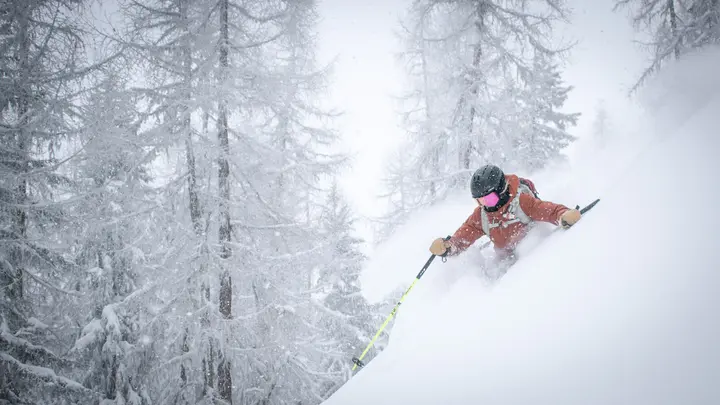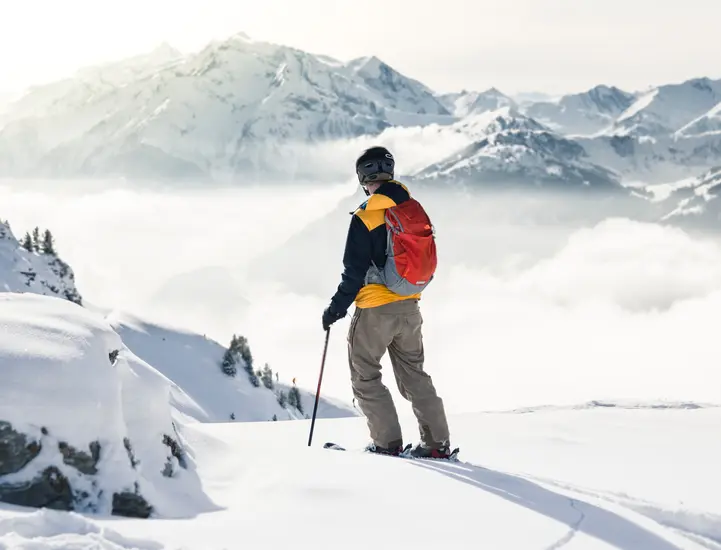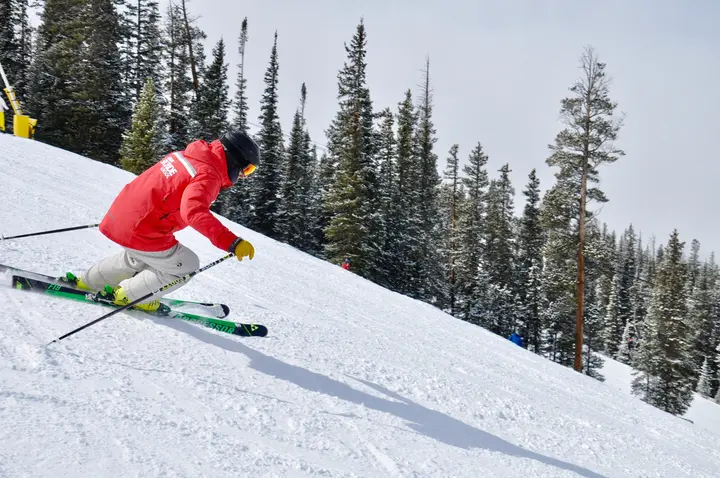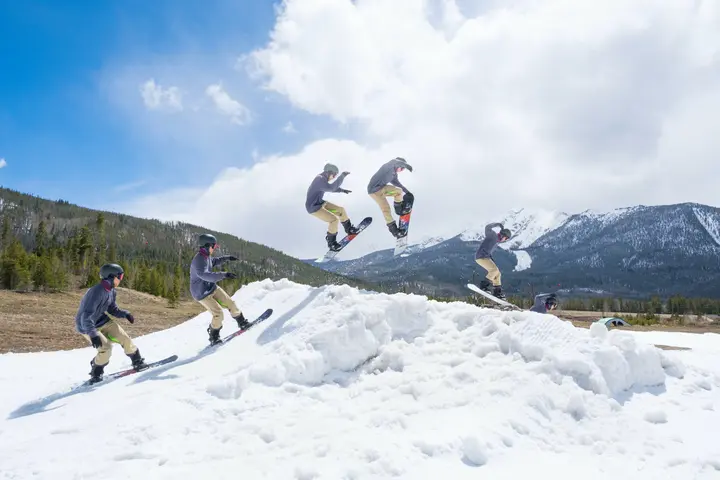Ski Safety for Beginners: Essential Tips for a Safe Winter Adventure

Figure skating is one of the most exciting and enjoyable activities in winter. It is an opportunity to enjoy the picturesque landscapes and feel free and fast. However, skiing for beginners can be challenging and intimidating at first. So, it's time to share with you some basic tips to ski safely and enjoy an unforgettable winter adventure.
Show key points
- Proper ski equipment, including a helmet, goggles, gloves, and layered clothing, is essential for safety and comfort on the slopes.
- Beginners should select ski slopes that match their skill level, starting with green slopes before progressing to more advanced terrain.
- Learning balance and body control helps prevent falls and injuries, making skiing safer and more enjoyable.
- ADVERTISEMENT
- Mastering basic techniques like standing up correctly and initiating movement smoothly builds confidence for new skiers.
- To avoid injuries, skiers must warm up beforehand, control their speed, and ski within their limits.
- Advanced skiers can enhance their capabilities by tackling challenging terrains, improving cornering techniques, and building core strength.
- Choosing scenic slopes with good infrastructure and manageable crowds adds to an enjoyable and memorable skiing experience.
Basic ski equipment: tool bag beginners should carry

When it comes to skiing, protecting yourself and equipping yourself with the right tools plays a crucial role in a safe and enjoyable experience. Here is a list of the most important things beginners should carry in their bag to make their experience easier on snowy slopes:
1. Helmet: The helmet is the most important piece of ski equipment to keep your head safe. Choose a helmet that is suitable for your head size and make sure it meets safety standards.
Recommend
2. Ski goggles: Ski goggles help protect your eyes from strong wind, snow and UV rays. Choose glasses that provide you with clear vision and fit your face shape.
3. Ski gloves: Ski gloves protect your hands from the bitter cold and provide you with a firm grip on ski sticks. Choose gloves that fit the size of your hands and provide warmth and comfort.
4. Warm socks: Invest in ski socks made of heat-insulating materials to keep your feet warm all day long. Make sure the socks fit the size of your shoes and allow your feet to breathe.
5. Ski clothing: Choose ski clothing that is durable, waterproof and allows free movement. Clothing should consist of multiple layers to ensure warmth and dryness.
6. Ski sticks: Ski sticks help maintain balance and control while skiing. Choose sticks that are suitable for your height and provide a secure grip.
With these essential equipment in your bag, you'll be ready to experience skiing safely and confidently. Don't forget to check your ski equipment before each trip and make sure it's in good condition. Have fun in the snowy mountains and have fun improving your skills in this wonderful sport!
Choosing the right place for skiing: how to find a slope that suits your skill level

After the necessary equipment and obtaining the right ski equipment, the most important question comes: where should you go skiing? Choosing the right place to ski is one of the most important decisions to make to ensure the perfect and safe skiing experience. It is a work that requires some planning and knowledge of the characteristics of the slopes and the nature of the place. Here we will explore some tips that will help you choose the right place to ski and enjoy an unforgettable experience.
1. Classification of slopes: Before you pull ropes and descend the mountain, try to figure out the classifications of the different slopes. Green slopes are easiest and suitable for beginners, followed by blue slopes that require better skills. Black slopes are the most difficult and suit applicants and experts. Choose the slope that matches your skill level to avoid excessive challenges.
2. Inquiry and research: Ask your friends or co-workers who do skiing which slopes they recommend. You can also search online for popular ski sites in your area. Read and learn from other people's experiences and choose where they have positive reviews and recommendations.
3. Congestion level: Excessive congestion may affect your experience and safety. Try to avoid crowded tourist places that are a popular destination for ski enthusiasts. It may be best to choose small, quiet slopes at the beginning of your experience before moving on to more crowded slopes.
4. Weather and weather conditions: Be sure to get the weather forecast and know the expected temperatures and weather conditions in the area you plan to go to. Make sure there are no strong storms or heavy snow that affect the visibility of the road and make skiing dangerous.
5. Infrastructure and public transport: Look for slopes that provide good infrastructure such as parking, restaurants or rest areas. Check the availability of public transport if that is your means of access.
6. Enjoy the scenery: Don't forget that the beauty of nature and scenery is an important part of the skiing experience. Choose a slope with magnificent views and stunning landscapes to enjoy skiing and capture unforgettable memories.
By choosing the right place to ski that suits your skill level and ensures your safety, you will enjoy the skiing experience with maximum pleasure and comfort. Get ready to enjoy stunning views and great ski challenges in a place that makes you feel like you are in a free-standing world on ice.
Learn balance and control: tips to avoid falls and keep your body straight

If you're a beginner in skiing, learning balance and control are the keys to enjoying your experience and avoiding painful falls. Balance and control can be very important to keep your body straight and avoid injuries. Here you will find some descriptive tips to help you achieve this:
1. Focus on a specific point: When you ski, find a fixed point to focus on. This can be a point in the slope or a tree near you. By focusing on this point, you will help yourself maintain your balance and avoid excessive deviation.
2. Use your arms: Point your arms in the direction of movement to help balance. Use them as stabilizers for your body and make them act as additional stabilizers.
3. Bend slightly: Bend slightly in the knees and joints to enhance your balance. This movement will help you direct the weight to the center of your body and improve your control over skiing.
4. Keep your calm posture: Try to stay calm and comfortable when skiing. Not being emotional and maintaining a calm posture will help you maintain your balance and avoid falling.
5. Do muscle strengthening exercises: Develop muscles that help you maintain balance and control. Basic strength exercises such as the abdomen, back, and legs will help you strengthen your body and achieve better straightness.
6. Follow the directions of professional trainers: If you work with a professional ski instructor, follow their directions carefully. They possess the knowledge and experience to help you learn balance and control techniques properly.
Remember, learning needs patience and regular practice. With time and continuous training, your balance and control skills will improve and you will gain the confidence to enjoy your adventure on the snowy slopes with confidence.
How to stand and go right: simple techniques to start confidently and smoothly

When you learn to skate as a beginner, standing and setting off correctly is of great importance in building confidence and enjoying your experience on snowy mountains. Follow these simple techniques to stand and go in a smooth and entertaining way:
1. Three-point pause: Start by preparing yourself for the start by placing the legs very close and keeping the weight on the heels and the middle of the feet. Then tilt the body slightly forward while keeping the back straight.
2. Steering and cruise control: Slightly separate the feet shoulder-width and use one foot for steering and cruise control. Apply light pressure to the right foot to move right and left foot to move left.
3. Start going: While standing, move the weight slightly back and then start bending your knees slightly and slowly flowing forward. Use the feet to gently push behind you, then rise to stand fully and use the legs for guidance.
4. Maintain balance: Keep the weight evenly distributed over the feet and use the arms to help maintain balance. Avoid excessive leaning forward or backward and try to relax and enjoy the ride.
5. Lateral balance training: Find a simple flat or stepped surface and try to balance on one foot without slipping. Shift weight from the right foot to the left foot and slowly vice versa to strengthen the leg muscles and improve lateral balance.
6. Practice starting and standing again: Repeat the process of starting and standing several times to increase confidence and promote balance. Do not forget to enjoy your experience and do not be shy about falling sometimes - it is an integral part of the learning process.
Using such simple techniques and periodic training, you will soon begin to skate with confidence and smoothness. Do not forget to practice and enjoy constantly improving your skills. Ice skating is not only an adventure and fun, it is also an art worth learning!
Avoiding injuries: how to stay safe and avoid possible injuries

When it comes to skiing, staying safe is the most important thing. The chance of getting injured in this sport is as high as possible, but don't worry, there are some procedures that can be followed to make sure that your skiing experience passes peacefully.
First of all, be sure to wear the necessary protective equipment. Be sure to wear a helmet that protects your head from serious injuries. The helmet should fit and cover the forehead and butt well. It is also advisable to wear goggles to protect your eyes from strong winds and flying snow.
Second, learn to control speed. Many injuries occur due to loss of control and impulsivity at insane speed. Make sure you use braking and steering technologies properly to maintain proper speed and avoid potential collisions.
Third, assess your skill level and set your limits. Don't try to ski on difficult and dangerous slopes before you're ready. Start by practicing on easy slopes and taking care of yourself before you advance to the most demanding challenges.
Fourth, do not forget to warm and extend before skiing. Do muscle stretching and warm-up exercises to make sure your body is ready to move and prevent muscle injuries.
Finally, don't forget to ski with a friend or group. Having a partner help in case of an emergency or stumbling gives extra confidence and ensures that there is someone to help you in case of any problem.
In the end, remember that skiing can be fun and safe if you follow the necessary measures to keep you safe. Feel free to consult with a professional instructor or ski teacher for additional advice on the right techniques and avoiding injuries. Enjoy skiing and always be safe while exploring the slopes.
Taking on advanced challenges: tips to develop your skills and overcome difficult terrain

In the world of skiing, it is not enough to master the basic level of skills, you must go beyond your limits and challenge yourself to develop and progress. If you want to tackle advanced challenges and overcome difficult terrain, here are some descriptive tips to develop your skills and reach a new level on your ski trip.
1. Expand the terrain: Challenge yourself and experience skiing on diverse terrains such as rugged slopes and exposed slopes. These experiences will help you improve your balance and coordination and increase your confidence in the face of different terrains.
2. Improve rollover techniques: To overcome difficult terrain, you must improve your rollover techniques. Practice advanced cornering and rollover techniques on difficult slopes, and improve speed control and balance during extreme cornering.
3. Develop body strength: Body strength is essential for controlling and endurance in difficult terrain. Do exercises that enhance the strength of core muscles such as the abdomen, back, and legs. You'll notice how easy it is for you to handle difficult terrain and withstand tough challenges.
4. Advanced lessons: Feel free to take advanced tutorials to develop your skiing skills. You'll learn new techniques and get feedback from professional trainers with experience in handling difficult terrain.
5. Psychological preparation: You must develop focus and self-confidence to face advanced challenges. Talk to yourself positively and remember that you are able to overcome any difficult terrain. Practice managing stress, focusing on your goal and enjoying the ride.
6. Be patient: It may take some time for you to develop in skiing and overcome difficult terrain. So, remember that evolution comes with patience and perseverance. Enjoy every step of the way and don't rush to progress.
Make your ski trip a fun challenge and discover your true skiing abilities. Use these descriptive tips to develop your skills and have the confidence to tackle advanced challenges and break limitations.

After reading these basic ski safety tips for beginners, you can now prepare for a safe and fun winter adventure. Do not always forget to enjoy the picturesque scenery and not lose sight of basic preventive measures. Be sure to wear protective equipment and practice the correct skiing techniques. Feel free to challenge yourself and discover your new abilities, but always with caution. Now, get ready to set off and enjoy an unforgettable skiing adventure in the snowy mountains!








